Deck 21: Reconstructing and Using Phylogenies
Question
Question
Question
Question
Question
Question
Question
Question
Question
Question
Question
Question
Question
Question
Question
Question
Question
Question
Question
Question
Question
Question
Question
Question
Question
Question
Question
Question
Question
Question
Question
Question
Question
Question
Question
Question
Question
Question
Question
Question
Question
Question
Question
Question
Question
Question
Question
Question
Question
Question
Question
Question
Question
Question
Question
Question
Question
Question
Question
Question
Question
Question
Question
Question
Question
Question
Question
Question
Question
Question
Question
Question
Question
Question
Question
Question
Question
Question
Question
Question

Unlock Deck
Sign up to unlock the cards in this deck!
Unlock Deck
Unlock Deck
1/246
Play
Full screen (f)
Deck 21: Reconstructing and Using Phylogenies
1
Refer to the figure showing a single viral plaque that was split every 400 generations and grown in the presence of a mutagen. 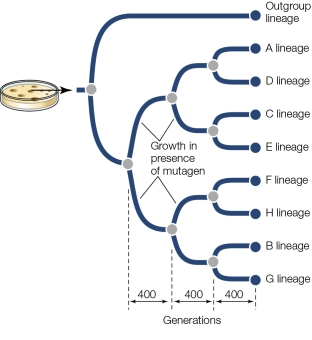 Based on this tree, which statement is true?
Based on this tree, which statement is true?
A) Lineage A should have evolved fewer differences from the outgroup than any other lineage.
B) Lineage D should have evolved more differences from lineage C than from lineage E.
C) Lineage H should have evolved about as many differences from lineage F as it has from lineage B.
D) Lineage G should have evolved more differences from the outgroup than from any other lineage.
E) Lineage A should have evolved as many differences from the outgroup as lineage F has from the outgroup.
 Based on this tree, which statement is true?
Based on this tree, which statement is true?A) Lineage A should have evolved fewer differences from the outgroup than any other lineage.
B) Lineage D should have evolved more differences from lineage C than from lineage E.
C) Lineage H should have evolved about as many differences from lineage F as it has from lineage B.
D) Lineage G should have evolved more differences from the outgroup than from any other lineage.
E) Lineage A should have evolved as many differences from the outgroup as lineage F has from the outgroup.
E
2
Two branches of fish diverged from each other 80 million years ago.The point of this divergence would be marked by a _______ in a phylogenetic tree.
A) node
B) lineage
C) synapomorphy
D) new root
E) time stamp
A) node
B) lineage
C) synapomorphy
D) new root
E) time stamp
A
3
The common ancestor of all of the species displayed in a phylogenetic tree lies at the _______ of the tree.
A) node
B) root
C) tip
D) taxon
E) clade
A) node
B) root
C) tip
D) taxon
E) clade
B
4
Consider five species of toads (A-E).Species A and B are sister species.Species C and D are also sister species.The clade containing species A and B is a sister to the clade containing species C and D.Not counting the root as a node, how many nodes would be found in a phylogenetic tree of species A, B, C, D, and E?
A) One
B) Two
C) Three
D) Four
E) Five
A) One
B) Two
C) Three
D) Four
E) Five

Unlock Deck
Unlock for access to all 246 flashcards in this deck.
Unlock Deck
k this deck
5
The absence of stripes on the wings is the ancestral state of a family of butterflies.One lineage contains five species, four with red stripes and one with no stripes.Genetic analysis revealed that the species without stripes recently lost these stripes.This is an example of _______, which is a(n) _______.
A) an evolutionary reversal; homoplasy
B) an evolutionary reversal; synapomorphy
C) convergent evolution; homoplasy
D) convergent evolution; synapomorphy
E) convergent evolution; evolutionary reversal
A) an evolutionary reversal; homoplasy
B) an evolutionary reversal; synapomorphy
C) convergent evolution; homoplasy
D) convergent evolution; synapomorphy
E) convergent evolution; evolutionary reversal

Unlock Deck
Unlock for access to all 246 flashcards in this deck.
Unlock Deck
k this deck
6
Consider five species of toads (A-E).Species A and B are sister species.Species C and D are also sister species.The clade containing species A and B is a sister to the clade containing species C and D.Not counting the root as a node, how many nodes would be found in a phylogenetic tree of species A, B, C, and D?
A) One
B) Two
C) Three
D) Four
E) Five
A) One
B) Two
C) Three
D) Four
E) Five

Unlock Deck
Unlock for access to all 246 flashcards in this deck.
Unlock Deck
k this deck
7
Refer to the figure showing a single viral plaque that was split every 400 generations and grown in the presence of a mutagen. 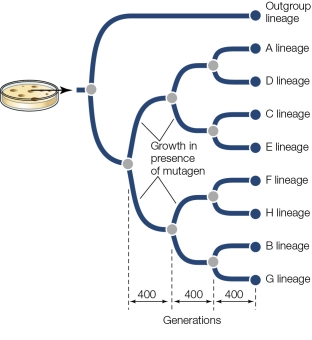 Based on this tree, which lineage should share the most synapomorphies with the E lineage?
Based on this tree, which lineage should share the most synapomorphies with the E lineage?
A) The B lineage
B) The D lineage
C) The F lineage
D) The G lineage
E) The outgroup
 Based on this tree, which lineage should share the most synapomorphies with the E lineage?
Based on this tree, which lineage should share the most synapomorphies with the E lineage?A) The B lineage
B) The D lineage
C) The F lineage
D) The G lineage
E) The outgroup

Unlock Deck
Unlock for access to all 246 flashcards in this deck.
Unlock Deck
k this deck
8
In the study of evolution, scientists often look at homologous features in species.Which is least suitable for use as a homologous feature?
A) A DNA sequence coding for a protein in frogs
B) An anatomical structure in beetles
C) An inherited behavioral pattern of marmots
D) The secondary structure of a protein in Arctic fish
E) Learned behavior in guppies
A) A DNA sequence coding for a protein in frogs
B) An anatomical structure in beetles
C) An inherited behavioral pattern of marmots
D) The secondary structure of a protein in Arctic fish
E) Learned behavior in guppies

Unlock Deck
Unlock for access to all 246 flashcards in this deck.
Unlock Deck
k this deck
9
Drosophila yakuba and D.santomea are each other's closest relatives.Therefore, they are considered _______ species.
A) rooted
B) paraphyletic
C) homologous
D) daughter
E) sister
A) rooted
B) paraphyletic
C) homologous
D) daughter
E) sister

Unlock Deck
Unlock for access to all 246 flashcards in this deck.
Unlock Deck
k this deck
10
Refer to the figure showing a single viral plaque that was split every 400 generations and grown in the presence of a mutagen. 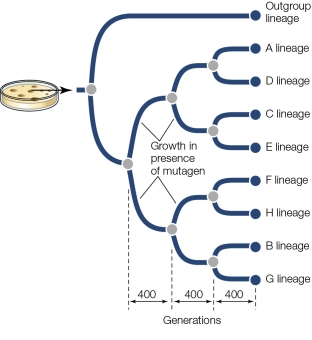 Based on this tree, which lineage should share the most synapomorphies with the H lineage?
Based on this tree, which lineage should share the most synapomorphies with the H lineage?
A) The D lineage
B) The F lineage
C) The G lineage
D) The C lineage
E) The outgroup
 Based on this tree, which lineage should share the most synapomorphies with the H lineage?
Based on this tree, which lineage should share the most synapomorphies with the H lineage?A) The D lineage
B) The F lineage
C) The G lineage
D) The C lineage
E) The outgroup

Unlock Deck
Unlock for access to all 246 flashcards in this deck.
Unlock Deck
k this deck
11
The wasp genus Nasonia contains all of the descendants of the common ancestor of its members.This genus therefore would be called
A) a clade.
B) a polyphyly.
C) a synapomorphy.
D) parsimonious.
E) self-compatible.
A) a clade.
B) a polyphyly.
C) a synapomorphy.
D) parsimonious.
E) self-compatible.

Unlock Deck
Unlock for access to all 246 flashcards in this deck.
Unlock Deck
k this deck
12
Consider a phylogeny of metazoans.Snakes, which lack limbs, evolved from vertebrates that had legs.The limbs of snakes disappeared by _______, and the backbones of snakes are a _______.
A) convergent evolution; synapomorphy
B) an evolutionary reversal; synapomorphy
C) convergent evolution; homoplastic trait
D) an evolutionary reversal; homoplastic trait
E) an evolutionary reversal; heteroplastic trait
A) convergent evolution; synapomorphy
B) an evolutionary reversal; synapomorphy
C) convergent evolution; homoplastic trait
D) an evolutionary reversal; homoplastic trait
E) an evolutionary reversal; heteroplastic trait

Unlock Deck
Unlock for access to all 246 flashcards in this deck.
Unlock Deck
k this deck
13
Consider five species of toads (A-E).Species A and B are sister species.Species C and D are also sister species.The clade containing species A and B is a sister to the clade containing species C and D.Not counting the root as a node, how many nodes would be found in a phylogenetic tree of species A, B, and C?
A) One
B) Two
C) Three
D) Four
E) Five
A) One
B) Two
C) Three
D) Four
E) Five

Unlock Deck
Unlock for access to all 246 flashcards in this deck.
Unlock Deck
k this deck
14
Refer to the phylogenetic tree below showing the phylogenetic relationships among eight species.Red dots indicate the appearance of derived traits. 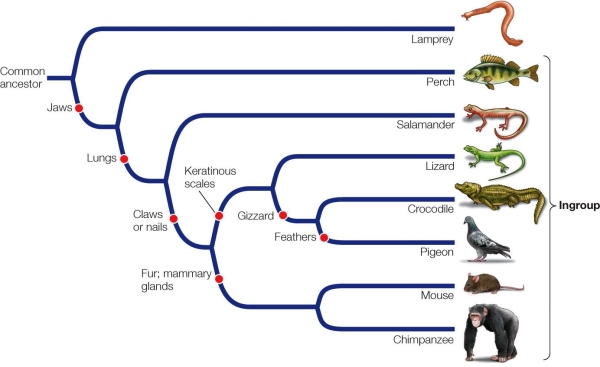 The positions of which two taxa could be reversed without changing the meaning of the tree?
The positions of which two taxa could be reversed without changing the meaning of the tree?
A) Crocodile and pigeon
B) Crocodile and lizard
C) Mouse and pigeon
D) Lizard and salamander
E) Lamprey and chimpanzee
 The positions of which two taxa could be reversed without changing the meaning of the tree?
The positions of which two taxa could be reversed without changing the meaning of the tree?A) Crocodile and pigeon
B) Crocodile and lizard
C) Mouse and pigeon
D) Lizard and salamander
E) Lamprey and chimpanzee

Unlock Deck
Unlock for access to all 246 flashcards in this deck.
Unlock Deck
k this deck
15
Two species of damselflies that are not sister species independently evolve a new mating behavior.This pattern is an example of _______, which is a(n)______.
A) an evolutionary reversal; homoplasy
B) an evolutionary reversal; synapomorphy
C) convergent evolution; homoplasy
D) convergent evolution; synapomorphy
E) convergent evolution; evolutionary reversal
A) an evolutionary reversal; homoplasy
B) an evolutionary reversal; synapomorphy
C) convergent evolution; homoplasy
D) convergent evolution; synapomorphy
E) convergent evolution; evolutionary reversal

Unlock Deck
Unlock for access to all 246 flashcards in this deck.
Unlock Deck
k this deck
16
The antifreeze proteins found in fish that live in very cold waters of the Arctic and Antarctic have evolved independently.The common ancestor of these fishes did not have the antifreeze proteins.Based on this information, which statement is true?
A) The antifreeze proteins in Arctic and Antarctic fish are homologous.
B) The antifreeze proteins in Arctic and Antarctic fish are homoplasies.
C) The Arctic and Antarctic fish form a clade.
D) The antifreeze proteins evolved by evolutionary reversals.
E) Convergent evolution does not occur for antifreeze proteins.
A) The antifreeze proteins in Arctic and Antarctic fish are homologous.
B) The antifreeze proteins in Arctic and Antarctic fish are homoplasies.
C) The Arctic and Antarctic fish form a clade.
D) The antifreeze proteins evolved by evolutionary reversals.
E) Convergent evolution does not occur for antifreeze proteins.

Unlock Deck
Unlock for access to all 246 flashcards in this deck.
Unlock Deck
k this deck
17
Members of genus X, a hypothetical taxon of invertebrates, have antennae with a variable number of segments.Species A and B each have ten segments; species C and D each have nine segments; and species E has eight segments.In all other genera in this family (including genus Y), all species have antennae with ten segments.Which character state is a synapomorphy that would be useful for determining evolutionary relationships within genus X?
A) Ten-segment antennae in species A and B
B) Ten-segment antennae in genus Y and in two species of genus X
C) Antennae with fewer than ten segments in species C, D, and E
D) Eight-segment antennae in species E
E) Antennae with more than ten segments in any species
A) Ten-segment antennae in species A and B
B) Ten-segment antennae in genus Y and in two species of genus X
C) Antennae with fewer than ten segments in species C, D, and E
D) Eight-segment antennae in species E
E) Antennae with more than ten segments in any species

Unlock Deck
Unlock for access to all 246 flashcards in this deck.
Unlock Deck
k this deck
18
Consider five species of toads (A-E).Species A and B are sister species.Species C and D are also sister species.The clade containing species A and B is a sister to the clade containing species C and D.Which species groups would be a clade?
A) Species A, B, and C
B) Species A, B, and D
C) Species A, C, and E
D) Species A, B, C, and D
E) Species B, C, D, and E
A) Species A, B, and C
B) Species A, B, and D
C) Species A, C, and E
D) Species A, B, C, and D
E) Species B, C, D, and E

Unlock Deck
Unlock for access to all 246 flashcards in this deck.
Unlock Deck
k this deck
19
Refer to the figure showing the wing and support structures (bones) of bat and bird wings. 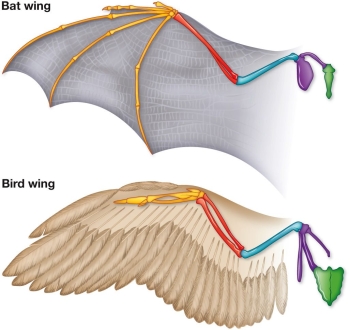 The similarities in the wings of bats and birds as adaptations for powered flight evolved through _______, which is a _______.
The similarities in the wings of bats and birds as adaptations for powered flight evolved through _______, which is a _______.
A) convergent evolution; homoplasy
B) convergent evolution; synapomorphy
C) evolutionary reversal; homoplasy
D) evolutionary reversal; synapomorphy
E) ancestral inheritance; synapomorphy
 The similarities in the wings of bats and birds as adaptations for powered flight evolved through _______, which is a _______.
The similarities in the wings of bats and birds as adaptations for powered flight evolved through _______, which is a _______.A) convergent evolution; homoplasy
B) convergent evolution; synapomorphy
C) evolutionary reversal; homoplasy
D) evolutionary reversal; synapomorphy
E) ancestral inheritance; synapomorphy

Unlock Deck
Unlock for access to all 246 flashcards in this deck.
Unlock Deck
k this deck
20
Which statement about phylogenetic trees is false?
A) The positions of branches on the x axis indicate the order in which lineages split.
B) The x axis represents time.
C) The y axis shows degree of similarity between contemporaneous species.
D) A split in the tree indicates the formation of two new species.
E) The break points of the tree are determined by the appearance of particular derived traits.
A) The positions of branches on the x axis indicate the order in which lineages split.
B) The x axis represents time.
C) The y axis shows degree of similarity between contemporaneous species.
D) A split in the tree indicates the formation of two new species.
E) The break points of the tree are determined by the appearance of particular derived traits.

Unlock Deck
Unlock for access to all 246 flashcards in this deck.
Unlock Deck
k this deck
21
According to the principle of parsimony, the best phylogenetic hypothesis is the one that requires the
A) fewest homologies.
B) most homoplasies.
C) fewest homoplasies.
D) most clades.
E) fewest clades.
A) fewest homologies.
B) most homoplasies.
C) fewest homoplasies.
D) most clades.
E) fewest clades.

Unlock Deck
Unlock for access to all 246 flashcards in this deck.
Unlock Deck
k this deck
22
Five different phylogenetic trees of a group of wild tomato species have been proposed.Trees A and B each require 16 homoplasies, but tree A requires 20 synapomorphies and tree B requires 22 synapomorphies.Tree C requires 17 homoplasies and 12 synapomorphies.Tree D requires 14 homoplasies and 21 synapomorphies.Finally, tree E requires 19 homoplasies and 11 synapomorphies.According to the principle of parsimony, which tree is the best?
A) Tree A
B) Tree B
C) Tree C
D) Tree D
E) Tree E
A) Tree A
B) Tree B
C) Tree C
D) Tree D
E) Tree E

Unlock Deck
Unlock for access to all 246 flashcards in this deck.
Unlock Deck
k this deck
23
Refer to the phylogenetic tree below showing the phylogenetic relationships among eight species.Red dots indicate the appearance of derived traits. 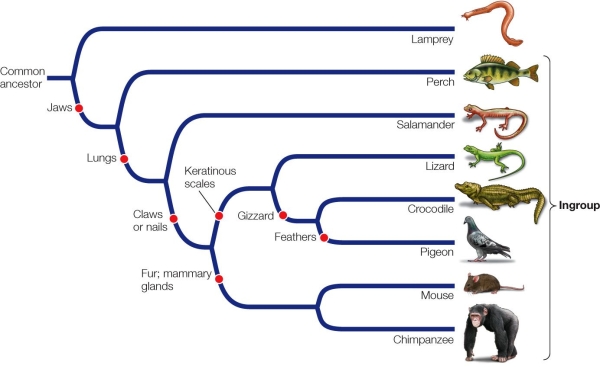 According to the phylogenetic tree, which synapomorphies unite the pigeon and the lizard?
According to the phylogenetic tree, which synapomorphies unite the pigeon and the lizard?
A) Feathers
B) A gizzard
C) Keratinous scales
D) Feathers and a gizzard
E) Feathers and keratinous scales
 According to the phylogenetic tree, which synapomorphies unite the pigeon and the lizard?
According to the phylogenetic tree, which synapomorphies unite the pigeon and the lizard?A) Feathers
B) A gizzard
C) Keratinous scales
D) Feathers and a gizzard
E) Feathers and keratinous scales

Unlock Deck
Unlock for access to all 246 flashcards in this deck.
Unlock Deck
k this deck
24
Refer to the figure. ![<strong>Refer to the figure. The figure shows the phylogeny of seven species of beetles (A- G).The figure also shows whether the beetles have (marked with check) or do not have (marked with an x) one of three stripes.It also indicates the color of the beetle (R for red and G for green).] Based on the phylogenetic tree and the principle of parsimony, The absence of stripe _______ in species _______ is most likely _______.</strong> A) 1; E and F; is most likely due to convergent evolution B) 1; E and F; a synapomorphy C) 2; E and F; due to convergent evolution D) 2; E and F; a synapomorphy E) 1; E and F; an evolutionary reversal](https://d2lvgg3v3hfg70.cloudfront.net/TB5650/11ea92b9_1e3d_c135_949e_41cc87661924_TB5650_00.jpg) The figure shows the phylogeny of seven species of beetles (A- G).The figure also shows whether the beetles have (marked with check) or do not have (marked with an x) one of three stripes.It also indicates the color of the beetle (R for red and G for green).] Based on the phylogenetic tree and the principle of parsimony, The absence of stripe _______ in species _______ is most likely _______.
The figure shows the phylogeny of seven species of beetles (A- G).The figure also shows whether the beetles have (marked with check) or do not have (marked with an x) one of three stripes.It also indicates the color of the beetle (R for red and G for green).] Based on the phylogenetic tree and the principle of parsimony, The absence of stripe _______ in species _______ is most likely _______.
A) 1; E and F; is most likely due to convergent evolution
B) 1; E and F; a synapomorphy
C) 2; E and F; due to convergent evolution
D) 2; E and F; a synapomorphy
E) 1; E and F; an evolutionary reversal
![<strong>Refer to the figure. The figure shows the phylogeny of seven species of beetles (A- G).The figure also shows whether the beetles have (marked with check) or do not have (marked with an x) one of three stripes.It also indicates the color of the beetle (R for red and G for green).] Based on the phylogenetic tree and the principle of parsimony, The absence of stripe _______ in species _______ is most likely _______.</strong> A) 1; E and F; is most likely due to convergent evolution B) 1; E and F; a synapomorphy C) 2; E and F; due to convergent evolution D) 2; E and F; a synapomorphy E) 1; E and F; an evolutionary reversal](https://d2lvgg3v3hfg70.cloudfront.net/TB5650/11ea92b9_1e3d_c135_949e_41cc87661924_TB5650_00.jpg) The figure shows the phylogeny of seven species of beetles (A- G).The figure also shows whether the beetles have (marked with check) or do not have (marked with an x) one of three stripes.It also indicates the color of the beetle (R for red and G for green).] Based on the phylogenetic tree and the principle of parsimony, The absence of stripe _______ in species _______ is most likely _______.
The figure shows the phylogeny of seven species of beetles (A- G).The figure also shows whether the beetles have (marked with check) or do not have (marked with an x) one of three stripes.It also indicates the color of the beetle (R for red and G for green).] Based on the phylogenetic tree and the principle of parsimony, The absence of stripe _______ in species _______ is most likely _______.A) 1; E and F; is most likely due to convergent evolution
B) 1; E and F; a synapomorphy
C) 2; E and F; due to convergent evolution
D) 2; E and F; a synapomorphy
E) 1; E and F; an evolutionary reversal

Unlock Deck
Unlock for access to all 246 flashcards in this deck.
Unlock Deck
k this deck
25
Humans and African apes (chimpanzees, bonobos, and gorillas) share traits, such as elongated skulls and shortened canine teeth, that other related species do not have.These characteristics are called
A) homoplasies.
B) synapomorphies.
C) reversals.
D) parsimonies.
E) heteroplasies.
A) homoplasies.
B) synapomorphies.
C) reversals.
D) parsimonies.
E) heteroplasies.

Unlock Deck
Unlock for access to all 246 flashcards in this deck.
Unlock Deck
k this deck
26
Four different phylogenetic trees of a group of salamanders have been proposed.Trees A and B each require 12 homoplasies, but tree A requires 14 synapomorphies and tree B requires 13 synapomorphies.Tree C requires 15 homoplasies and 13 synapomorphies.Finally, tree D requires 10 homoplasies and 15 synapomorphies.According to the principle of parsimony, which tree is the best?
A) Tree A
B) Tree B
C) Tree C
D) Tree D
E) The trees are equally good.
A) Tree A
B) Tree B
C) Tree C
D) Tree D
E) The trees are equally good.

Unlock Deck
Unlock for access to all 246 flashcards in this deck.
Unlock Deck
k this deck
27
There are five species of beetles.Species A and B have red colored wings, whereas species C and D have pale wings and species E lacks wings completely.Which piece of evidence would best support the hypothesis that red wings are a synapomorphy?
A) Evidence from morphology unrelated to wings that A and B are sister species.
B) DNA evidence showing that species B and D are sister species.
C) Fossil evidence showing that the common ancestor of all five species lacked wings.
D) Fossil evidence showing that the common ancestor of all five species had red wings.
E) Evidence showing that species A and B live in an environment that favors red wings, whereas the other three species live in an environment that favors pale wings
A) Evidence from morphology unrelated to wings that A and B are sister species.
B) DNA evidence showing that species B and D are sister species.
C) Fossil evidence showing that the common ancestor of all five species lacked wings.
D) Fossil evidence showing that the common ancestor of all five species had red wings.
E) Evidence showing that species A and B live in an environment that favors red wings, whereas the other three species live in an environment that favors pale wings

Unlock Deck
Unlock for access to all 246 flashcards in this deck.
Unlock Deck
k this deck
28
Some species in a hypothetical family of beetles are winged, and others are wingless.Which would be most useful in determining whether having wings or being wingless was the ancestral trait?
A) Homoplasies
B) Homologies
C) An outgroup
D) An ingroup
E) Maximum likelihood methods
A) Homoplasies
B) Homologies
C) An outgroup
D) An ingroup
E) Maximum likelihood methods

Unlock Deck
Unlock for access to all 246 flashcards in this deck.
Unlock Deck
k this deck
29
Refer to the figure. 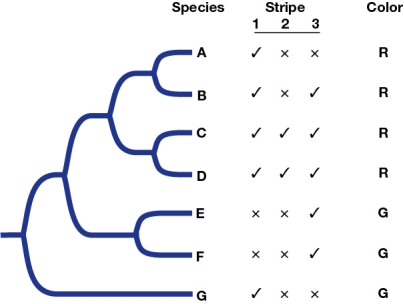 In the clade that contains species A, B, C, and D, species _______ would be part of the ingroup, and species _______ would be an outgroup.
In the clade that contains species A, B, C, and D, species _______ would be part of the ingroup, and species _______ would be an outgroup.
A) A; B
B) A; E
C) E; A
D) E; D
E) E; F
 In the clade that contains species A, B, C, and D, species _______ would be part of the ingroup, and species _______ would be an outgroup.
In the clade that contains species A, B, C, and D, species _______ would be part of the ingroup, and species _______ would be an outgroup.A) A; B
B) A; E
C) E; A
D) E; D
E) E; F

Unlock Deck
Unlock for access to all 246 flashcards in this deck.
Unlock Deck
k this deck
30
Consider five species of toads.Species A and B are sister species.Species C and D are also sister species.The clade containing species A and B is a sister to the clade containing species C and D.Which species is most likely to share synapomorphies with species E?
A) Species A
B) Species B
C) Species C
D) Species D
E) All of the above are equally likely to share synapomorphies with species E.
A) Species A
B) Species B
C) Species C
D) Species D
E) All of the above are equally likely to share synapomorphies with species E.

Unlock Deck
Unlock for access to all 246 flashcards in this deck.
Unlock Deck
k this deck
31
Refer to the phylogenetic tree showing the phylogenetic relationships among eight species.Red dots indicate the appearance of derived traits. 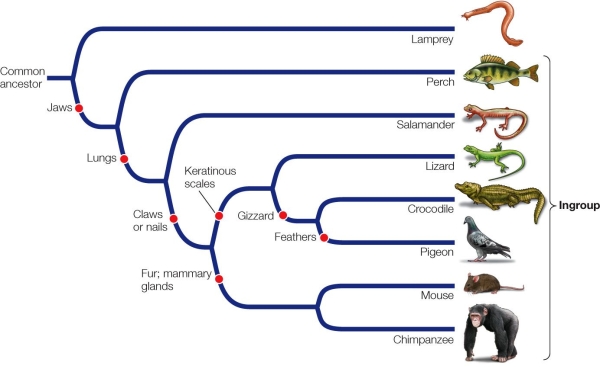 According to the phylogenetic tree, chimpanzees and pigeons share _______ of the listed synapomorphies.
According to the phylogenetic tree, chimpanzees and pigeons share _______ of the listed synapomorphies.
A) one
B) two
C) three
D) four
E) at least five
 According to the phylogenetic tree, chimpanzees and pigeons share _______ of the listed synapomorphies.
According to the phylogenetic tree, chimpanzees and pigeons share _______ of the listed synapomorphies.A) one
B) two
C) three
D) four
E) at least five

Unlock Deck
Unlock for access to all 246 flashcards in this deck.
Unlock Deck
k this deck
32
Refer to the figure. 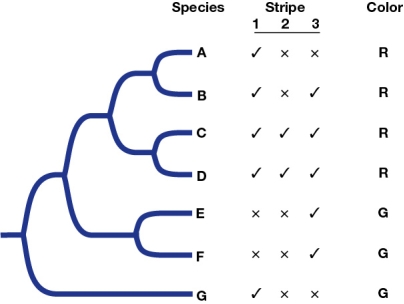 Which of the following is most likely a homoplasy?
Which of the following is most likely a homoplasy?
A) Species A and B both having stripe 1
B) Species A and D both having stripe 1
C) Species A and B both lacking stripe 2
D) Species A and G both lacking stripe 2
E) Species A and G both lacking stripe 3
 Which of the following is most likely a homoplasy?
Which of the following is most likely a homoplasy?A) Species A and B both having stripe 1
B) Species A and D both having stripe 1
C) Species A and B both lacking stripe 2
D) Species A and G both lacking stripe 2
E) Species A and G both lacking stripe 3

Unlock Deck
Unlock for access to all 246 flashcards in this deck.
Unlock Deck
k this deck
33
Refer to the figure. 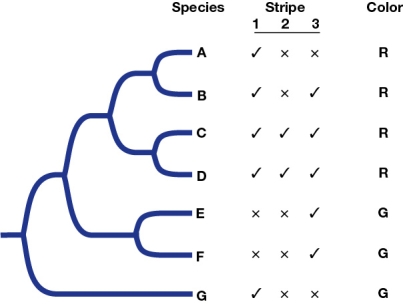 Which of the following is most likely a synapomorphy?
Which of the following is most likely a synapomorphy?
A) Species A and D both having stripe 1
B) Species E and F both lacking stripe 1
C) Species E and G both lacking stripe 2
D) Species A and G both lacking stripe 3
E) Species E and G both being green
 Which of the following is most likely a synapomorphy?
Which of the following is most likely a synapomorphy?A) Species A and D both having stripe 1
B) Species E and F both lacking stripe 1
C) Species E and G both lacking stripe 2
D) Species A and G both lacking stripe 3
E) Species E and G both being green

Unlock Deck
Unlock for access to all 246 flashcards in this deck.
Unlock Deck
k this deck
34
Refer to the figure showing the wing and support structures (bones) of bat and bird wings. 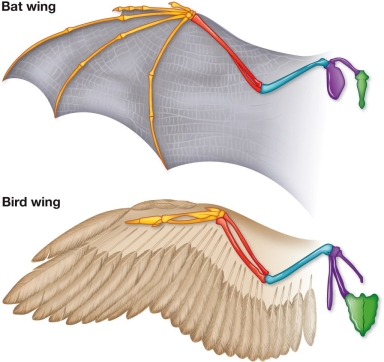 The overall arrangements of the support structures of the bat and bird wings are _______ traits.
The overall arrangements of the support structures of the bat and bird wings are _______ traits.
A) homoplastic
B) homologous
C) ancestral
D) nonhomologous
E) derived
 The overall arrangements of the support structures of the bat and bird wings are _______ traits.
The overall arrangements of the support structures of the bat and bird wings are _______ traits.A) homoplastic
B) homologous
C) ancestral
D) nonhomologous
E) derived

Unlock Deck
Unlock for access to all 246 flashcards in this deck.
Unlock Deck
k this deck
35
Refer to the figure. 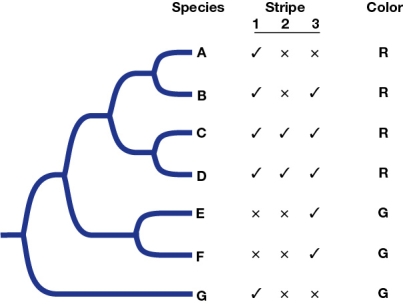 Which statement about the evolution of color is most likely true?
Which statement about the evolution of color is most likely true?
A) Green coloration is a synapomorphy of the clade consisting of species E, F, and G.
B) Red coloration is a syapomorphy of the clade consisting of species A, B, C, and D.
C) Red coloration evolved more than once in this group.
D) Red coloration is ancestral.
E) Green coloration evolved more than once in this group.
 Which statement about the evolution of color is most likely true?
Which statement about the evolution of color is most likely true?A) Green coloration is a synapomorphy of the clade consisting of species E, F, and G.
B) Red coloration is a syapomorphy of the clade consisting of species A, B, C, and D.
C) Red coloration evolved more than once in this group.
D) Red coloration is ancestral.
E) Green coloration evolved more than once in this group.

Unlock Deck
Unlock for access to all 246 flashcards in this deck.
Unlock Deck
k this deck
36
Refer to the phylogenetic tree showing the phylogenetic relationships among eight species.Red dots indicate the appearance of derived traits. 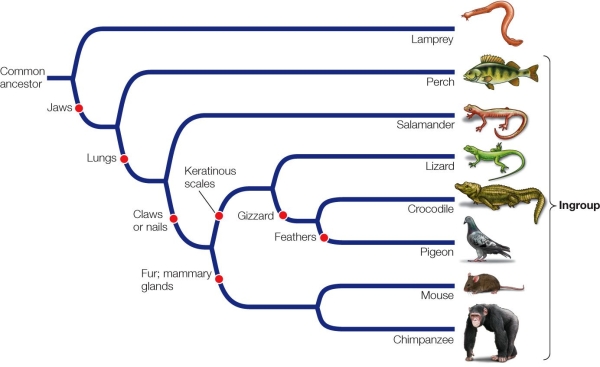 According to the phylogenetic tree, which synapomorphy unites the salamander and the lizard?
According to the phylogenetic tree, which synapomorphy unites the salamander and the lizard?
A) Feathers
B) A gizzard
C) Keratinous scales
D) Claws or nails
E) Lungs
 According to the phylogenetic tree, which synapomorphy unites the salamander and the lizard?
According to the phylogenetic tree, which synapomorphy unites the salamander and the lizard?A) Feathers
B) A gizzard
C) Keratinous scales
D) Claws or nails
E) Lungs

Unlock Deck
Unlock for access to all 246 flashcards in this deck.
Unlock Deck
k this deck
37
The common ancestor of humans and the other great apes walked on all fours, while humans are bipeds.Bipedalism in humans is thus a(n) _______ trait.
A) ancestral
B) homoplastic
C) synapomorphic
D) derived
E) monophyletic
A) ancestral
B) homoplastic
C) synapomorphic
D) derived
E) monophyletic

Unlock Deck
Unlock for access to all 246 flashcards in this deck.
Unlock Deck
k this deck
38
Refer to the figure. 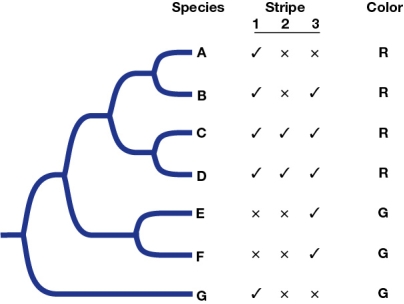 Which of the following statements is true?
Which of the following statements is true?
A) Species A is evolutionarily closer to species C than it is to species D.
B) Species A is evolutionarily closer to species D than it is to species C.
C) The evolutionary distance from species E to species F is the same as that from species D to species E.
D) The evolutionary distance from species E to species F is the same as that from species C to species D.
E) The evolutionary distance from species A to species C is the same as that from species B to species C.
 Which of the following statements is true?
Which of the following statements is true?A) Species A is evolutionarily closer to species C than it is to species D.
B) Species A is evolutionarily closer to species D than it is to species C.
C) The evolutionary distance from species E to species F is the same as that from species D to species E.
D) The evolutionary distance from species E to species F is the same as that from species C to species D.
E) The evolutionary distance from species A to species C is the same as that from species B to species C.

Unlock Deck
Unlock for access to all 246 flashcards in this deck.
Unlock Deck
k this deck
39
Species A and B have long wings, whereas species C has short wings.Which piece of evidence would best support the hypothesis that long wings are a synapomorphy?
A) Fossil evidence showing that the common ancestor of species A, B, and C had long wings
B) DNA evidence showing that species B and C are sister species
C) DNA evidence showing that species A and C are sister species
D) Fossil evidence showing that the common ancestor of species A, B, and C had short wings
E) Evidence showing that species A and B live in an environment that favors long wings, whereas species C lives in an environment that favors short wings
A) Fossil evidence showing that the common ancestor of species A, B, and C had long wings
B) DNA evidence showing that species B and C are sister species
C) DNA evidence showing that species A and C are sister species
D) Fossil evidence showing that the common ancestor of species A, B, and C had short wings
E) Evidence showing that species A and B live in an environment that favors long wings, whereas species C lives in an environment that favors short wings

Unlock Deck
Unlock for access to all 246 flashcards in this deck.
Unlock Deck
k this deck
40
Consider five species of toads.Species A and B are sister species.Species C and D are also sister species.The clade containing species A and B is a sister to the clade containing species C and D.Which species is most likely to share synapomorphies with species C?
A) Species A
B) Species B
C) Species D
D) Species E
E) All of the above are equally likely to share synapomorphies with species C.
A) Species A
B) Species B
C) Species D
D) Species E
E) All of the above are equally likely to share synapomorphies with species C.

Unlock Deck
Unlock for access to all 246 flashcards in this deck.
Unlock Deck
k this deck
41
Which kind of data would likely be the most useful for distinguishing ancestral traits from derived ones?
A) Developmental
B) Behavioral
C) Paleontological
D) Morphological
E) Molecular
A) Developmental
B) Behavioral
C) Paleontological
D) Morphological
E) Molecular

Unlock Deck
Unlock for access to all 246 flashcards in this deck.
Unlock Deck
k this deck
42
In the case in which phylogenetic analysis of HIV was used to convict a physician of purposely injecting blood from his HIV-positive patient into his former girlfriend, the victim's HIV sequences were _______ and the patient's HIV sequences were _______.
A) monophyletic; monophyletic
B) monophyletic; paraphyletic
C) monophyletic; polyphyletic
D) paraphyletic; monophyletic
E) paraphyletic; paraphyletic
A) monophyletic; monophyletic
B) monophyletic; paraphyletic
C) monophyletic; polyphyletic
D) paraphyletic; monophyletic
E) paraphyletic; paraphyletic

Unlock Deck
Unlock for access to all 246 flashcards in this deck.
Unlock Deck
k this deck
43
Which is a property of HIV that would make it difficult to trace the source of the virus from one person to the next?
A) The host can have a genetically diverse population of viruses.
B) HIV evolves very slowly within the host.
C) The transmission of the virus involves very few (often just one) viral particles.
D) Molecular phylogenies of viruses cannot be constructed.
E) The population of HIV is too small to trace.
A) The host can have a genetically diverse population of viruses.
B) HIV evolves very slowly within the host.
C) The transmission of the virus involves very few (often just one) viral particles.
D) Molecular phylogenies of viruses cannot be constructed.
E) The population of HIV is too small to trace.

Unlock Deck
Unlock for access to all 246 flashcards in this deck.
Unlock Deck
k this deck
44
Histone genes, which evolve very slowly, would most likely be used to study relationships
A) among very similar species.
B) within the same genus.
C) among organisms that live in the same locality.
D) relationships among prokaryotic organisms that diverged recently.
E) between different phyla.
A) among very similar species.
B) within the same genus.
C) among organisms that live in the same locality.
D) relationships among prokaryotic organisms that diverged recently.
E) between different phyla.

Unlock Deck
Unlock for access to all 246 flashcards in this deck.
Unlock Deck
k this deck
45
Which factor is not a limitation of the use of morphology in phylogenetic analysis?
A) Some morphological variation has a genetic basis.
B) Few morphological traits can be directly compared across distant taxa.
C) Some taxa exhibit little morphological diversity.
D) Temperature changes can affect morphology.
E) Nutritional differences during development can affect morphology.
A) Some morphological variation has a genetic basis.
B) Few morphological traits can be directly compared across distant taxa.
C) Some taxa exhibit little morphological diversity.
D) Temperature changes can affect morphology.
E) Nutritional differences during development can affect morphology.

Unlock Deck
Unlock for access to all 246 flashcards in this deck.
Unlock Deck
k this deck
46
Mitochondrial DNA is most useful for phylogenetic analysis
A) in the study of relatively ancient relationships.
B) in groups with few species that have survived to the present.
C) of closely related animal (but not plant) species.
D) of prokaryotes.
E) of paternal inheritance.
A) in the study of relatively ancient relationships.
B) in groups with few species that have survived to the present.
C) of closely related animal (but not plant) species.
D) of prokaryotes.
E) of paternal inheritance.

Unlock Deck
Unlock for access to all 246 flashcards in this deck.
Unlock Deck
k this deck
47
A major disadvantage of maximum likelihood methods is that they
A) are difficult to fit into a statistical framework.
B) require explicit models of evolutionary change.
C) can be used only on molecular data.
D) can be used only for closely related species.
E) can only be used on morphological data.
A) are difficult to fit into a statistical framework.
B) require explicit models of evolutionary change.
C) can be used only on molecular data.
D) can be used only for closely related species.
E) can only be used on morphological data.

Unlock Deck
Unlock for access to all 246 flashcards in this deck.
Unlock Deck
k this deck
48
In the case where phylogenetic analysis of HIV was used to convict a physician of purposely injecting blood from his HIV-positive patient into his former girlfriend, which would be evidence that would most likely exonerate the physician?
A) The victim's HIV sequences were a subset of the patient's HIV sequences.
B) The victim's HIV sequences formed a clade.
C) The victim's HIV sequences were a subset of sequences from another HIV-positive individual from the community.
D) The patient's HIV sequences were a subset of sequences from another HIV-positive individual from the community.
E) The patient's HIV sequences were sister to the victim's sequences.
A) The victim's HIV sequences were a subset of the patient's HIV sequences.
B) The victim's HIV sequences formed a clade.
C) The victim's HIV sequences were a subset of sequences from another HIV-positive individual from the community.
D) The patient's HIV sequences were a subset of sequences from another HIV-positive individual from the community.
E) The patient's HIV sequences were sister to the victim's sequences.

Unlock Deck
Unlock for access to all 246 flashcards in this deck.
Unlock Deck
k this deck
49
A skeptic argues that because phylogenetic methods can be flawed, the results from such methods are questionable.What result or analysis provides the best validation of the accuracy of the methods used to reconstruct phylogenetic relationships?
A) Results from molecular data often match results from morphological data.
B) Advances in computational power allow for the use maximum likelihood methods.
C) Experimental studies using bacteriophage
D) The development of the molecular clock
E) The principle of parsimony
A) Results from molecular data often match results from morphological data.
B) Advances in computational power allow for the use maximum likelihood methods.
C) Experimental studies using bacteriophage
D) The development of the molecular clock
E) The principle of parsimony

Unlock Deck
Unlock for access to all 246 flashcards in this deck.
Unlock Deck
k this deck
50
Which trait would be least useful in a phylogenetic analysis?
A) A trait that is altered easily by small changes in temperature
B) A trait that involves genetically inherited behaviors
C) A trait that is detectable in observations of early development
D) A trait that can be studied in museum specimens
E) A trait that corresponds directly with sequence differences in a single gene
A) A trait that is altered easily by small changes in temperature
B) A trait that involves genetically inherited behaviors
C) A trait that is detectable in observations of early development
D) A trait that can be studied in museum specimens
E) A trait that corresponds directly with sequence differences in a single gene

Unlock Deck
Unlock for access to all 246 flashcards in this deck.
Unlock Deck
k this deck
51
In a phylogenetic reconstruction experiment by Hillis et al., researchers used a viral culture, adding mutagens over the course of the experiment.This method _______ the accuracy of the reconstruction, because the mutagen _______ the amount of change and the degree of homoplasy that is typical of organisms measured in average phylogenetic analyses.
A) calls into question; increases
B) calls into question; decreases
C) calls into question; maintains
D) confirms; increases
E) confirms; maintains
A) calls into question; increases
B) calls into question; decreases
C) calls into question; maintains
D) confirms; increases
E) confirms; maintains

Unlock Deck
Unlock for access to all 246 flashcards in this deck.
Unlock Deck
k this deck
52
Microsatellite DNA has a high mutation rate and thus evolves quickly.It would most likely be useful in determining phylogenetic relationships
A) in bacteria.
B) in fungi.
C) among closely related species.
D) among orders of insects.
E) in plants.
A) in bacteria.
B) in fungi.
C) among closely related species.
D) among orders of insects.
E) in plants.

Unlock Deck
Unlock for access to all 246 flashcards in this deck.
Unlock Deck
k this deck
53
In systematics and phylogeny, the fossil record is especially important because
A) most groups are well represented.
B) DNA can be extracted from nearly all ancient fossils and then analyzed.
C) random mutations make most biochemical methods unreliable.
D) it can provide the absolute timing of evolutionary events.
E) it provides the only data that are useful in reconstructing the past.
A) most groups are well represented.
B) DNA can be extracted from nearly all ancient fossils and then analyzed.
C) random mutations make most biochemical methods unreliable.
D) it can provide the absolute timing of evolutionary events.
E) it provides the only data that are useful in reconstructing the past.

Unlock Deck
Unlock for access to all 246 flashcards in this deck.
Unlock Deck
k this deck
54
Epigenetic changes (such as changes in methylation state) be useful in phylogenetic analyses if they
A) are affected by temperatures the organism experiences.
B) are affected by the food consumed by the organism.
C) are inherited from parent to child.
D) are variable depending on the age of the organism.
E) can be altered by the microbiota.
A) are affected by temperatures the organism experiences.
B) are affected by the food consumed by the organism.
C) are inherited from parent to child.
D) are variable depending on the age of the organism.
E) can be altered by the microbiota.

Unlock Deck
Unlock for access to all 246 flashcards in this deck.
Unlock Deck
k this deck
55
Biologists are interested in determining the phylogenetic relationships of a group of beetles.Information about which of the following types of behavior would be least useful in reconstructing phylogenies?
A) Inherited
B) Locomotion
C) Foraging
D) Learned
E) Mating
A) Inherited
B) Locomotion
C) Foraging
D) Learned
E) Mating

Unlock Deck
Unlock for access to all 246 flashcards in this deck.
Unlock Deck
k this deck
56
What is the primary limitation of the use of fossil data in phylogenetic studies?
A) Fossil data cannot be used to determine whether a trait is ancestral or derived.
B) The fossil record is missing or fragmentary for many groups of organisms.
C) The fossil record cannot tell us what organisms looked like in the past.
D) Only DNA data is useful in phylogenetic analysis.
E) The fossil record does not provide information about when groups diverged from one another.
A) Fossil data cannot be used to determine whether a trait is ancestral or derived.
B) The fossil record is missing or fragmentary for many groups of organisms.
C) The fossil record cannot tell us what organisms looked like in the past.
D) Only DNA data is useful in phylogenetic analysis.
E) The fossil record does not provide information about when groups diverged from one another.

Unlock Deck
Unlock for access to all 246 flashcards in this deck.
Unlock Deck
k this deck
57
Studies testing the creation of phylogenies of bacteriophage T7 showed that
A) phylogenetic methods accurately reconstruct the evolutionary history of bacteriophage T7.
B) phylogenetic methods perform poorly in reconstructing evolutionary history.
C) the molecular clock is invalid.
D) phylogenetic methods require DNA sequencing of all viral plaques at the nodes.
E) an outgroup lineage could not be created.
A) phylogenetic methods accurately reconstruct the evolutionary history of bacteriophage T7.
B) phylogenetic methods perform poorly in reconstructing evolutionary history.
C) the molecular clock is invalid.
D) phylogenetic methods require DNA sequencing of all viral plaques at the nodes.
E) an outgroup lineage could not be created.

Unlock Deck
Unlock for access to all 246 flashcards in this deck.
Unlock Deck
k this deck
58
Which statement concerning the use of mathematical models such as maximum likelihood methods is false?
A) They identify the tree that is most likely to have produced the observed data.
B) They are most often used with molecular data.
C) They incorporate more information than parsimony methods do.
D) They are easier to treat in a statistical framework than other models are.
E) They cannot account for transitions between purines and pyrimidines.
A) They identify the tree that is most likely to have produced the observed data.
B) They are most often used with molecular data.
C) They incorporate more information than parsimony methods do.
D) They are easier to treat in a statistical framework than other models are.
E) They cannot account for transitions between purines and pyrimidines.

Unlock Deck
Unlock for access to all 246 flashcards in this deck.
Unlock Deck
k this deck
59
Refer to the figure. 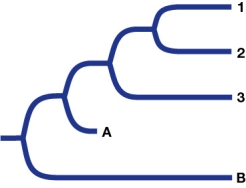 The figure shows the phylogeny of three extant species of turtles.Species 1 and 2 have a particular bone structure, while species 3 does not.The most generally accepted opinion is that the structure evolved after species 1 and 2 diverged from species 3.Recently, some scientists have questioned this and suggested that the structure evolved before species 1, 2, and 3 diverged from the common ancestor and that the structure was lost in species 3.Two fossils (A and B) have been discovered.Which information from these fossils would best support the new claim that species 3 lost the structure?
The figure shows the phylogeny of three extant species of turtles.Species 1 and 2 have a particular bone structure, while species 3 does not.The most generally accepted opinion is that the structure evolved after species 1 and 2 diverged from species 3.Recently, some scientists have questioned this and suggested that the structure evolved before species 1, 2, and 3 diverged from the common ancestor and that the structure was lost in species 3.Two fossils (A and B) have been discovered.Which information from these fossils would best support the new claim that species 3 lost the structure?
A) Look at species A. If the structure is present there, the new claim is supported.
B) Look at species A. If the structure is absent there, the new claim is supported.
C) Look at species B. If the structure is present there, the new claim is supported.
D) Look at species B. If the structure is absent there, the new claim is supported.
E) Fossil data cannot be used to address this question.
 The figure shows the phylogeny of three extant species of turtles.Species 1 and 2 have a particular bone structure, while species 3 does not.The most generally accepted opinion is that the structure evolved after species 1 and 2 diverged from species 3.Recently, some scientists have questioned this and suggested that the structure evolved before species 1, 2, and 3 diverged from the common ancestor and that the structure was lost in species 3.Two fossils (A and B) have been discovered.Which information from these fossils would best support the new claim that species 3 lost the structure?
The figure shows the phylogeny of three extant species of turtles.Species 1 and 2 have a particular bone structure, while species 3 does not.The most generally accepted opinion is that the structure evolved after species 1 and 2 diverged from species 3.Recently, some scientists have questioned this and suggested that the structure evolved before species 1, 2, and 3 diverged from the common ancestor and that the structure was lost in species 3.Two fossils (A and B) have been discovered.Which information from these fossils would best support the new claim that species 3 lost the structure?A) Look at species A. If the structure is present there, the new claim is supported.
B) Look at species A. If the structure is absent there, the new claim is supported.
C) Look at species B. If the structure is present there, the new claim is supported.
D) Look at species B. If the structure is absent there, the new claim is supported.
E) Fossil data cannot be used to address this question.

Unlock Deck
Unlock for access to all 246 flashcards in this deck.
Unlock Deck
k this deck
60
Repetitive DNA sequences usually evolve very quickly.Based on this fact, molecules that have a rapid mutation rate are best suited to the study of relationships among
A) very closely related species.
B) all organisms.
C) extinct organisms.
D) duplicated genes.
E) organisms that diverged long ago.
A) very closely related species.
B) all organisms.
C) extinct organisms.
D) duplicated genes.
E) organisms that diverged long ago.

Unlock Deck
Unlock for access to all 246 flashcards in this deck.
Unlock Deck
k this deck
61
Which of the following is the largest (most inclusive) taxon?
A) Genus
B) Family
C) Species
D) Order
E) Class
A) Genus
B) Family
C) Species
D) Order
E) Class

Unlock Deck
Unlock for access to all 246 flashcards in this deck.
Unlock Deck
k this deck
62
In modern systematics, each family name is based on
A) the name of a member genus.
B) a characteristic common to all members.
C) the name of the order to which the family belongs.
D) the name of the largest member species.
E) the Latin name for the organisms.
A) the name of a member genus.
B) a characteristic common to all members.
C) the name of the order to which the family belongs.
D) the name of the largest member species.
E) the Latin name for the organisms.

Unlock Deck
Unlock for access to all 246 flashcards in this deck.
Unlock Deck
k this deck
63
The suffix "-idae" (as in "Sciuridae") refers to organisms of which kingdom?
A) Bacteria
B) Fungi
C) Plants
D) Animals
E) Algae
A) Bacteria
B) Fungi
C) Plants
D) Animals
E) Algae

Unlock Deck
Unlock for access to all 246 flashcards in this deck.
Unlock Deck
k this deck
64
Which statement about the molecular clock is true?
A) It requires monophyletic taxa.
B) It requires calibration with independent data, such as from the fossil record.
C) It requires binomial nomenclature.
D) It can only be used if the species diverged less than about 100 million years ago.
E) It can only be used if the species diverged more than about 20 million years ago.
A) It requires monophyletic taxa.
B) It requires calibration with independent data, such as from the fossil record.
C) It requires binomial nomenclature.
D) It can only be used if the species diverged less than about 100 million years ago.
E) It can only be used if the species diverged more than about 20 million years ago.

Unlock Deck
Unlock for access to all 246 flashcards in this deck.
Unlock Deck
k this deck
65
Which of the following would most likely involve use of a molecular clock?
A) Determining whether a doctor infected someone with his HIV-positive patient's blood
B) Determining when West Nile virus arrived in the United States
C) Determining whether female preference evolved before or after the male trait in a genus of birds
D) Reconstructing the ancestral states of proteins that code for an enzyme
E) Assessing the number of times self-incompatibility evolved in a family of plants
A) Determining whether a doctor infected someone with his HIV-positive patient's blood
B) Determining when West Nile virus arrived in the United States
C) Determining whether female preference evolved before or after the male trait in a genus of birds
D) Reconstructing the ancestral states of proteins that code for an enzyme
E) Assessing the number of times self-incompatibility evolved in a family of plants

Unlock Deck
Unlock for access to all 246 flashcards in this deck.
Unlock Deck
k this deck
66
Humans and chimpanzees diverged about 6 million years ago.If 12 nucleotide substitutions have occurred between human and chimpanzee lineages in a sequence of mitochondrial DNA and 36 have occurred between humans and gibbons, according to the molecular clock hypothesis, humans and gibbons separated _______ million years ago.
A) 2
B) 6
C) 12
D) 18
E) 36
A) 2
B) 6
C) 12
D) 18
E) 36

Unlock Deck
Unlock for access to all 246 flashcards in this deck.
Unlock Deck
k this deck
67
Which of the following is the smallest taxon?
A) Kingdom
B) Family
C) Phylum
D) Class
E) Order
A) Kingdom
B) Family
C) Phylum
D) Class
E) Order

Unlock Deck
Unlock for access to all 246 flashcards in this deck.
Unlock Deck
k this deck
68
Which statement about taxonomic ranks is correct?
A) A phylum can contain multiple kingdoms.
B) An order can contain multiple families.
C) A genus can contain multiple families.
D) A class can contain multiple phyla.
E) An order can contain multiple phyla.
A) A phylum can contain multiple kingdoms.
B) An order can contain multiple families.
C) A genus can contain multiple families.
D) A class can contain multiple phyla.
E) An order can contain multiple phyla.

Unlock Deck
Unlock for access to all 246 flashcards in this deck.
Unlock Deck
k this deck
69
Refer to the figure showing a single viral plaque that was split every 400 generations and grown in the presence of a mutagen. 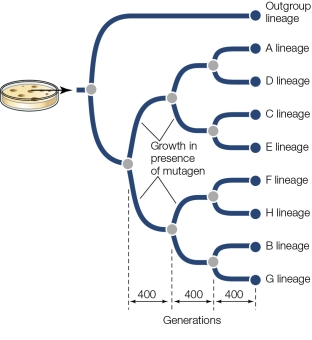 How many generations of evolution have occurred between the A lineage and the C lineage? Remember that evolution is occurring in both lineages.
How many generations of evolution have occurred between the A lineage and the C lineage? Remember that evolution is occurring in both lineages.
A) 400
B) 800
C) 1,200
D) 1,600
E) 3,200
 How many generations of evolution have occurred between the A lineage and the C lineage? Remember that evolution is occurring in both lineages.
How many generations of evolution have occurred between the A lineage and the C lineage? Remember that evolution is occurring in both lineages.A) 400
B) 800
C) 1,200
D) 1,600
E) 3,200

Unlock Deck
Unlock for access to all 246 flashcards in this deck.
Unlock Deck
k this deck
70
Refer to the figure showing a phylogenetic tree of immunodeficiency viruses. 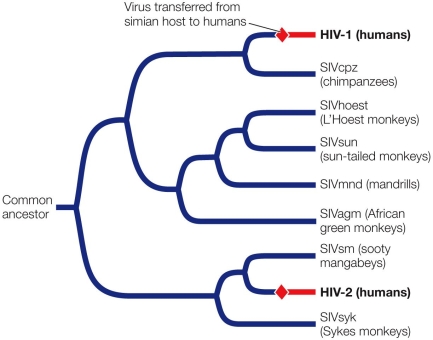 Based on the diagram, which statement about HIV is true?
Based on the diagram, which statement about HIV is true?
A) HIV in humans forms a clade.
B) All HIV variants in humans were derived from viruses in chimpanzees.
C) All HIV variants in humans were derived from viruses in sooty mangabeys.
D) HIV likely entered the human population from hunters who cut themselves as they were skinning primates.
E) The two forms of HIV arose from the same simian species.
 Based on the diagram, which statement about HIV is true?
Based on the diagram, which statement about HIV is true?A) HIV in humans forms a clade.
B) All HIV variants in humans were derived from viruses in chimpanzees.
C) All HIV variants in humans were derived from viruses in sooty mangabeys.
D) HIV likely entered the human population from hunters who cut themselves as they were skinning primates.
E) The two forms of HIV arose from the same simian species.

Unlock Deck
Unlock for access to all 246 flashcards in this deck.
Unlock Deck
k this deck
71
Drosophila mauritiana and D.melanogaster diverged 2 million years ago.Between these species, 40 nucleotide differences have accumulated at a gene.At that same gene, D.mauritiana and D.simulans have accumulated 8 nucleotide differences.Assuming that a molecular clock is operating, the best estimate for the divergence time between D.mauritiana and D.simulans is _______ years ago.
A) 100,000
B) 200,000
C) 300,000
D) 400,000
E) 800,000
A) 100,000
B) 200,000
C) 300,000
D) 400,000
E) 800,000

Unlock Deck
Unlock for access to all 246 flashcards in this deck.
Unlock Deck
k this deck
72
Studies of female platyfish, whose male counterparts have a variety of tail shapes, show that the females have a preference for male fish with artificial swordlike structures attached to their tails.This observation is most consistent with the
A) notion of a molecular clock.
B) maximum likelihood principle.
C) sensory exploitation hypothesis.
D) principle of homoplasy.
E) parsimony principle.
A) notion of a molecular clock.
B) maximum likelihood principle.
C) sensory exploitation hypothesis.
D) principle of homoplasy.
E) parsimony principle.

Unlock Deck
Unlock for access to all 246 flashcards in this deck.
Unlock Deck
k this deck
73
Which sequence represents a correct size ranking of taxonomic categories, from smallest to largest?
A) Family, genus, order, species
B) Species, genus, order, family
C) Species, genus, family, order
D) Genus, species, family, order
E) Genus, family, species, order
A) Family, genus, order, species
B) Species, genus, order, family
C) Species, genus, family, order
D) Genus, species, family, order
E) Genus, family, species, order

Unlock Deck
Unlock for access to all 246 flashcards in this deck.
Unlock Deck
k this deck
74
Refer to the figure showing a phylogenetic tree of immunodeficiency viruses. 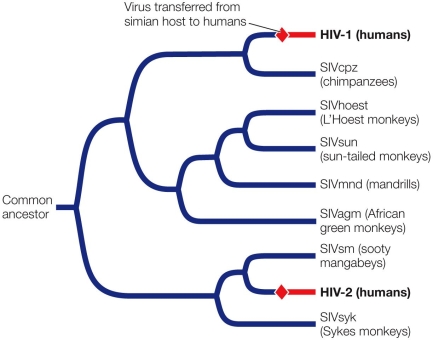 Based on the figure, which statement is false?
Based on the figure, which statement is false?
A) HIV viruses evolved from simian immunodeficiency virus (SIV).
B) HIV-1 and HIV-2 are more closely related to each other than to any of the simian immunodeficiency viruses.
C) There are two different HIV strains.
D) SIVcpz could be considered an outgroup for the clade of SIV that is found in sun-tailed and African green monkeys.
E) SIVsm and HIV-2 are sister clades.
 Based on the figure, which statement is false?
Based on the figure, which statement is false?A) HIV viruses evolved from simian immunodeficiency virus (SIV).
B) HIV-1 and HIV-2 are more closely related to each other than to any of the simian immunodeficiency viruses.
C) There are two different HIV strains.
D) SIVcpz could be considered an outgroup for the clade of SIV that is found in sun-tailed and African green monkeys.
E) SIVsm and HIV-2 are sister clades.

Unlock Deck
Unlock for access to all 246 flashcards in this deck.
Unlock Deck
k this deck
75
Which statement related to the use of molecular clocks is false?
A) Different genes evolve at different rates.
B) There are differences in evolutionary rates among species, related to generation times.
C) There are species differences related to environment.
D) There are species differences due to efficiencies of DNA repair systems.
E) It is not possible to compare the same protein from different species.
A) Different genes evolve at different rates.
B) There are differences in evolutionary rates among species, related to generation times.
C) There are species differences related to environment.
D) There are species differences due to efficiencies of DNA repair systems.
E) It is not possible to compare the same protein from different species.

Unlock Deck
Unlock for access to all 246 flashcards in this deck.
Unlock Deck
k this deck
76
Refer to the phylogenetic tree. 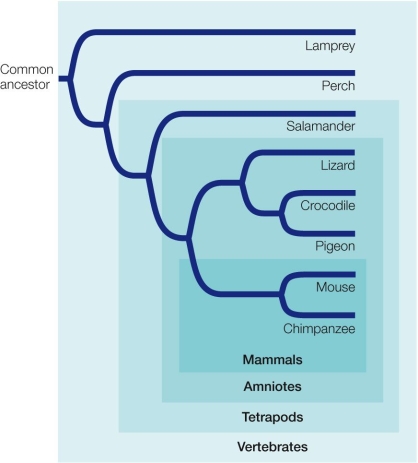 All clades are subsets of larger clades.The most inclusive clade in the figure is _______; the least inclusive clade includes the _______.
All clades are subsets of larger clades.The most inclusive clade in the figure is _______; the least inclusive clade includes the _______.
A) mammals; mouse
B) tetrapods; salamander
C) amniotes; lizard
D) vertebrates; chimpanzee
E) mammals; lamprey
 All clades are subsets of larger clades.The most inclusive clade in the figure is _______; the least inclusive clade includes the _______.
All clades are subsets of larger clades.The most inclusive clade in the figure is _______; the least inclusive clade includes the _______.A) mammals; mouse
B) tetrapods; salamander
C) amniotes; lizard
D) vertebrates; chimpanzee
E) mammals; lamprey

Unlock Deck
Unlock for access to all 246 flashcards in this deck.
Unlock Deck
k this deck
77
Based on what you know about biological classification, "Araceae" should refer to a(n)
A) family of plants.
B) genus of animals.
C) genus of plants.
D) family of animals.
E) order of plants.
A) family of plants.
B) genus of animals.
C) genus of plants.
D) family of animals.
E) order of plants.

Unlock Deck
Unlock for access to all 246 flashcards in this deck.
Unlock Deck
k this deck
78
Which concept adds a dimension of time to a phylogenetic analysis?
A) Maximum likelihood
B) Parsimony
C) Synapomorphy
D) Occam's razor
E) A molecular clock
A) Maximum likelihood
B) Parsimony
C) Synapomorphy
D) Occam's razor
E) A molecular clock

Unlock Deck
Unlock for access to all 246 flashcards in this deck.
Unlock Deck
k this deck
79
Suppose that mice and humans differ by 20 substitutions in their globin genes, and rats and mice differ by 5 substitutions.On the basis of other evidence, we know that the ancestor to humans and mice lived 80 million years ago.Assuming the molecular clock is operating, rats and mice split from each other _______ million years ago.
A) 5
B) 10
C) 20
D) 40
E) 80
A) 5
B) 10
C) 20
D) 40
E) 80

Unlock Deck
Unlock for access to all 246 flashcards in this deck.
Unlock Deck
k this deck
80
Which event or situation would violate an assumption of the molecular clock?
A) The gene that encodes histone H4 evolves much more slowly than the gene that encodes the enzyme hexokinase.
B) Mitochondrial DNA evolves faster than most nuclear DNA.
C) Lineages with organisms that have long generation times evolve more slowly than those with shorter generation times.
D) The taxa involved evolved from a common ancestor more than 100 million years ago.
E) The taxa involved evolved from a common ancestor less than 10,000 years ago.
A) The gene that encodes histone H4 evolves much more slowly than the gene that encodes the enzyme hexokinase.
B) Mitochondrial DNA evolves faster than most nuclear DNA.
C) Lineages with organisms that have long generation times evolve more slowly than those with shorter generation times.
D) The taxa involved evolved from a common ancestor more than 100 million years ago.
E) The taxa involved evolved from a common ancestor less than 10,000 years ago.

Unlock Deck
Unlock for access to all 246 flashcards in this deck.
Unlock Deck
k this deck



